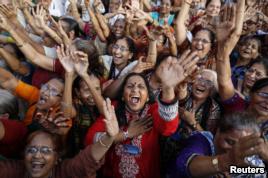

On March 20, the United Nations celebrated its third annual International Day of Happiness.
The UN created the holiday to include happiness as an indicator (指标)as to how we are succeeding as a global community.
In 2012, the UN secretary general, Ban Ki Moon, said that for too long the world has used Gross National Product (GNP) to measure the well-being of a country's population. In other words, the amount of money people made. Money certainly does help a country's and a person's well-being(康乐,安宁). But it is not the only factor.
If you live in Latin America, chances are you are happy, according to Gallup's(美国新墨西哥州城市名) "Positive Experience Index(指数)." This Gallup index found that day-to-day people in Latin America are some of the happiest people on the planet.
In fact, for the first time in Gallup's 10-year history of global tracking of happiness, all of the top 10 countries with the highest "Positive Experience Index" scores are in Latin America.
Gallup representatives asked adults in 143 countries the following questions: "Did you feel well-rested yesterday?" "Were you treated with respect all day yesterday? "Did you smile or laugh a lot?" "Did you learn or do something interesting?"
They collected the "yes" responses from these questions into what they call a "Positive Experience Index" score for each country. The index score for the world in 2014 is 71. This number has remained steady through the years. More than 70% of people worldwide said they had fun, smiled or laughed a lot, felt well rested and respected.
Gallup's happiness poll (民意检测)also found that having money is not necessarily the key to happiness. Guatemala (危地马拉)is one of the poorest countries in the world in terms of Gross Domestic Product (GDP) but ties for second when it comes to positive emotions.
本时文内容由奇速英语国际教育研究院原创编写,禁止复制和任何商业用途,版权所有,侵权必究!
1.International Day of Happiness is a(an)____holiday.
A traditional
B ancient
C religious
D recent
解析:选D。D。推理判断题。根据第1段 the United Nations celebrated its third annual International Day of Happiness.可知今年是‘国际幸福日’的第三个年头,所以是近年来才有的节日。
2.What does Mr. Ban Ki Moon mean by saying: ‘for too long the world has used GNP to measure the well-being of a country's population’ ?
A Measuring the well-being of a country's population is important for the world.
B The amount of money people made does help a country's and a person's well-being.
C GNP should not be the only factor to measure the well-being of a country's population.
D The amount of money people made is a good indicator to a succeeding community.
解析:选C。C。细节理解题。根据第3段可知,多年来,人们习惯用‘国民生产总值’来衡量国家人民的安康。这里他用了too long, 表明这样不好。而本段最后,他也说it is not the only factor.
3.What is the result of the 10-year global tracking of happiness?
A Latin Americans are the happiest people on the planet.
B Latin Americans are the most well-being people in the world.
C Day to day, people in Latin America are tracking happiness.
D The top 10 countries are trying to improve their "Positive Experience Index" scores.
解析:选A。A。推理判断题。根据第5段可知,十年的追踪调查表明,‘幸福指数’最高的前10个国家都在拉丁美洲,这表明那里的人是最快乐的。
4.The "Positive Experience Index" score is____to their questions.
A the steady answers
B the worldwide answers
C the correct responses
D the "yes" responses
解析:选D。D。细节理解题。根据倒数第2段第1句可知,幸福指数的调查方法是统计人们对所提问题的正面且积极的回答,即文中的:collected the "yes" responses 。
5.What is the ‘Positive Experience Index’ score in Guatemala?
A The second at the bottom.
B The second at the top.
C The poorest in the world.
D The poorest in Latin American countries.
解析:选B。B。细节理解题。根据文章最后1句ties for second when it comes to positive emotions可知这里tie的意思是‘打平’,即‘与...相等’,换句话说:并列第二。